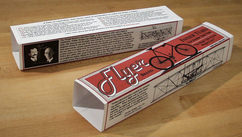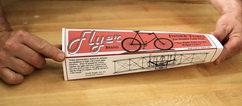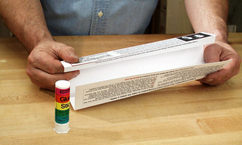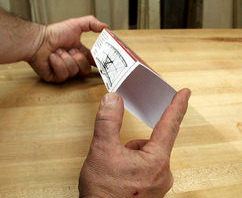|

 Down
Down

 Inner Tube Box
Inner Tube Box
Experiment

(You are here.)
Wind Tunnel
And Balance 
1902 Wright
Glider Model 



  Need
to Need
to
find your
bearings?
Try
these
navigation aids:
If this
is your first
visit, please stop by:
Something
to share?
Please:



|
|
Available in Française, Español, Português, Deutsch, Россию,
中文,
日本, and others.
 ver
one
hundred years ago, Wilbur Wright discovered a method for controlling an aircraft in flight
that history now remembers as "wing-warping" or the "aileron
principle." Wilbur and Orville had already grasped the theory behind this method some
months before. After reading a book on the mechanics of bird flight, they observed
buzzards circling above the Great Miami River. Will and Orv determined that a bird rolls
left or right by changing the angle at which the wings meet the wind, tilting one up and
the other down simultaneously. (See
An Inkling of an Idea.) They tried to design a mechanism that would do this
on a glider, but their initial attempts were too complex and heavy. ver
one
hundred years ago, Wilbur Wright discovered a method for controlling an aircraft in flight
that history now remembers as "wing-warping" or the "aileron
principle." Wilbur and Orville had already grasped the theory behind this method some
months before. After reading a book on the mechanics of bird flight, they observed
buzzards circling above the Great Miami River. Will and Orv determined that a bird rolls
left or right by changing the angle at which the wings meet the wind, tilting one up and
the other down simultaneously. (See
An Inkling of an Idea.) They tried to design a mechanism that would do this
on a glider, but their initial attempts were too complex and heavy.
Then
one early summer day in 1899, Wilbur was chatting with a customer in the Wright's bicycle shop.
The customer had come for an inner tube — a piece of cutting-edge bicycle technology
at the time — and Wilbur was idly toying with the pasteboard box it had come in. He
happened to notice that when he squeezed two diagonal corners on one end of the box and
the two opposite corners on the other end, the box twisted. In his mind's eye, Wilbur
imagined that the top and bottom of the box were the wings of a biplane. With a set of
cables, he could draw the struts and spars together, "warping" the wings so one
side tilted up and the other down. (See
A Warped Experiment.)
Wilbur had hit upon what engineers call the "elegant solution" to his and
Orville's control problem. It was not the most important discovery the Wright brothers
made, but it was the first and possibly the most thrilling. The elation of having stumbled
upon an effective solution to a problem that had eluded men for centuries was the hook
that drew the brothers on to seven years of painstaking, dangerous work.
This was the first of a long series of thorny aeronautical problems the
brothers had to solve one by one until
they at last arrived at one of the most elegant machines of all time -- the world's first
practical airplane.
|

To twist a small, slender box...

... squeeze two sets of corners together. Click on the photo to see
what we mean.

Wilbur and Orville used this phenomenon to control their airplanes. They twisted the wings, tilting
one side up and the other down. The "up" side produced more lift than the
"down" side, and the airplane rolled right or left.
|
Making the Box
To repeat Wilbur's experiment, you'll have to make your own 1899
inner tube box. You can't just use a modern inner tube box; they
aren't the same. In Wilbur's day, inner tubes were long rubber
cylinders whose length equaled the circumference of the tire rim.
They weren't joined end to end to make a donut shape. These tubes
were folded up and slid into long, slender boxes. When you fold up
modern donut-shaped inner tubes, they fit best into short, squarish
boxes. These are difficult-going-on-impossible to twist. Wilbur
might never have discovered this method of wing warping if early
inner tubes were donut-shaped.
To make a vintage inner tube box: 1. Download the
PDF
image of the design. Right click on the thumbnail to the right and choose to
save the file to your desktop or another convenient place on your
hard drive.2. Open
the PDF in any PDF viewer such as
Adobe Reader.
Print out the image on 8-1/2" by 11" card stock in the landscape mode.
If you don't have card stock, print it out on
ordinary paper and then paste it to a piece of thin pasteboard with rubber cement or spray
adhesive.
4. Fold the card stock or the pasteboard
on the dotted lines. Here's a tip:
To help make
crisp, straight folds, score the stock with the dull edge of a table knife. Don't
cut through the stock; just crush the paper fibers along the line you want to bend.
Use a straightedge to guide the knife. The scored line will be much easier
to bend and the bend will be much neater.
5. There should be
a 1/2"-wide tab at the top of the printed box stock. Glue this tab to the inside surface
of the box, even
with the bottom edge. This will form an open-ended box. You can also use tape or staples
to assemble the box, but glue works best.
|

Download this box design to print your own inner tube box.

Score the stock with the blunt edge of a knife to make
crisp folds.

Glue the tab at the top of the stock to the bottom surface to form a box.
|
Twisting the Box
To
make the make your inner tube box twist as Wilbur did, you must hold it just right and
squeeze the proper corners.
1. Hold two diagonal corners on
the one end of the box between your thumb and index finger. With your other hand,
hold the two opposite diagonal corners in the same manner.
2. Gently squeeze both sets of
corners together. The box will take on a spiral twist (also called a helicoidal
twist).
3. To twist the box in the other
direction, shift your grip so you holding the opposite sets of diagonal corners.
Then squeeze. Or, if you don't want to let go of the box, simply spread the
corners that you're already holding. This brings the opposite set of corners together, and
the twist reverses itself.
4. Look at the box from the side
as you squeeze and spread the corners. Wilbur saw the top and bottom of his box as the
wings of a biplane, each side presenting itself at a different angle to the wind. This, he
knew, would create a difference in lift. When the wings were twisted, one side
would have more than the other. The side with increased lift would rise, while the side
with decreased lift would sink. This would cause the biplane to roll right or left. He
showed this to Orville, and the two brothers decided to build a model glider to test
Wilbur's idea. Wilbur flew the model as a kite in late July 1899. And it worked.
|

Hold the box as shown.

Gently squeeze the corners together to twist the box in one direction.

Spread the corners to reverse the twist.
|
|
|
|

